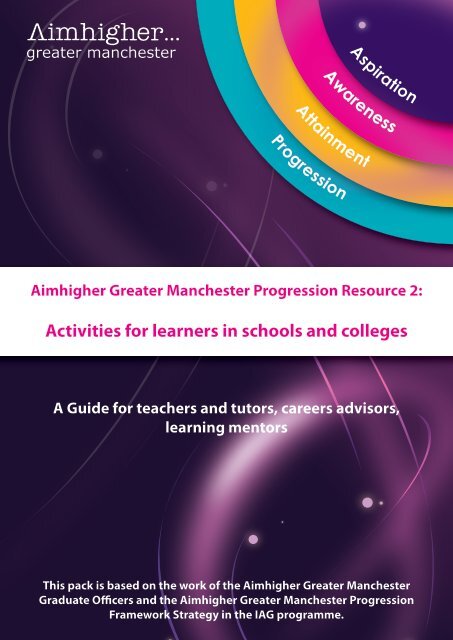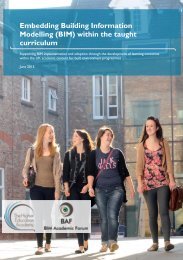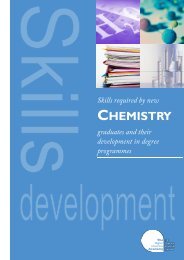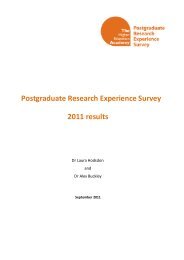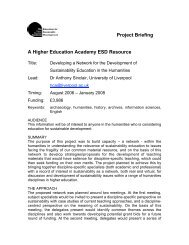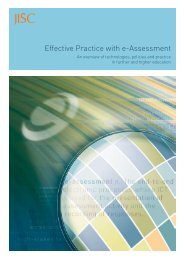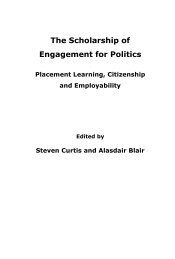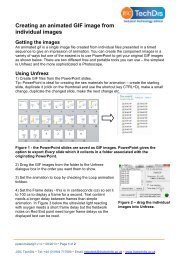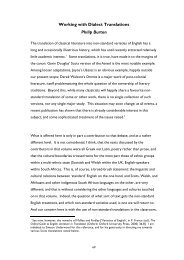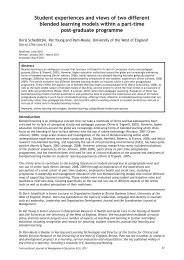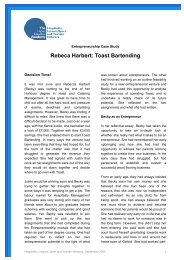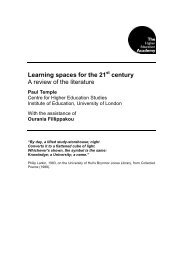Download this PDF (2.55MB) - Higher Education Academy
Download this PDF (2.55MB) - Higher Education Academy
Download this PDF (2.55MB) - Higher Education Academy
You also want an ePaper? Increase the reach of your titles
YUMPU automatically turns print PDFs into web optimized ePapers that Google loves.
Aspiration<br />
Awareness<br />
Attainment<br />
Progression<br />
Aimhigher Greater Manchester Progression Resource 2:<br />
Activities for learners in schools and colleges<br />
A Guide for teachers and tutors, careers advisors,<br />
learning mentors<br />
This pack is based on the work of the Aimhigher Greater Manchester<br />
Graduate Officers and the Aimhigher Greater Manchester Progression<br />
Framework Strategy in the IAG programme.
The Aimhigher Greater Manchester Progression Resource<br />
Introduction<br />
Aimhigher Greater Manchester was the largest of 40 government funded partnerships in<br />
England working with schools, colleges, universities and others to encourage progression<br />
to higher education for young people from groups whose access to university has been<br />
limited. The Aimhigher programme began in 2004 and closed on July 31st 2011.<br />
In 2010, national statistics showed a 30% increase in progression to higher education from<br />
1<br />
young people in the lowest socio-economic groups in the lifetime of Aimhigher . In<br />
2<br />
Greater Manchester, the upward trend is more marked still .<br />
Aimhigher: what do we know works?<br />
Partnership – collaboration between schools, colleges and universities coordinated<br />
through nominated members of staff in schools and colleges<br />
Targeting – identifying those young people who most need support to progress and<br />
prioritising resources for them<br />
Starting young – raising awareness of HE before GCSE choices are made in order to<br />
raise aspirations, inform choices and increase motivation to achieve<br />
Learner Progression Framework – sequenced interventions over several years,<br />
matched to learning stage, for those in the target learner group, over several years.<br />
Tracking, monitoring and evaluation – tracking learner progress and recording the<br />
impact on motivation, GCSE results, progression at 16 and progression to higher<br />
education.<br />
And the best activities were: IAG matched to progression stage, building<br />
relationships between young people and current HE students, visits and residentials<br />
at universities, curriculum based projects.<br />
1 Corver M., (2010), Trends in young participation in higher education: core results for England, <strong>Higher</strong><br />
<strong>Education</strong> Funding Council for England, Bristol<br />
2<br />
Aimhigher Greater Manchester Annual Statistical Report 2010, accessible from www.uni4me.co.uk<br />
3
The Aimhigher Greater Manchester Progression Resource<br />
The Progression Resource has been produced by the Aimhigher Greater Manchester team<br />
to secure the legacy of Aimhigher and enable partners and others to continue to develop<br />
models of practice that raise the aspirations of young people and support them to<br />
progress to higher education. Designed primarily for use by schools and colleges and<br />
based on reflection on the experience of Aimhigher, the progression resource pack<br />
consists of three booklets, each with associated resources available electronically. The<br />
booklets cover:<br />
1. The Information, Advice and Guidance Progression Resource for teachers, tutors,<br />
learning support and advisory staff, based on the Aimhigher IAG staff<br />
development and disability programmes.<br />
2. The guide to delivering a programme of progression sessions for young people,<br />
based on the Aimhigher Graduate Officer programmes.<br />
3. The guide to working with higher education students to provide support and role<br />
models for younger learners, based on the Aimhigher Associates programme.<br />
University outreach opportunities and the learner progression<br />
framework<br />
In addition to the activities and programmes suggested in these booklets, the universities<br />
of Greater Manchester are offering a wide range of outreach opportunities for young<br />
people from schools and colleges in the area, including campus visits, student<br />
ambassadors, curriculum enrichment and staff development. Our hope is that you will<br />
devise a programme of activities – a learner progression framework - that suits the needs<br />
of your learners and staff and includes in-school or in-college interventions alongside<br />
opportunities offered by higher education institutions.<br />
Continued access to Aimhigher resources and links<br />
All the resources, copies of the progression booklets, and details of the universities’<br />
outreach offer plus links to their websites and to a range of valuable information and<br />
useful organisations will be available on the uni4me website – www.uni4me.co.uk The<br />
website will be maintained in the future by the universities themselves.<br />
4
Aimhigher Greater Manchester Progression Resource 2:<br />
Activities for learners in schools and colleges<br />
Contents<br />
1. Introduction<br />
2. The Progression Framework<br />
3. Sessions for pre 16 learners<br />
4. Sessions for post 16 learners<br />
5. Useful websites<br />
6. Evaluation<br />
7. Working in partnership with universities<br />
8. Listening to learners<br />
1. Introduction<br />
This pack and its resources are aimed at careers coordinators, PSHE coordinators, year<br />
group leaders, teachers and learning mentors who are committed to improving the life<br />
chances of their young people and enhancing the attainment and progression rates of<br />
their institution.<br />
2. Progression Framework<br />
Aimhigher provided information, advice and guidance activities and experiences that<br />
aimed to increase the awareness and aspirations of the young people involved. These<br />
activities were matched to the age and stage of learners and linked to other activities<br />
within a progression framework. Key features of the progression framework include<br />
agreed objectives for each key stage coupled with agreed targeting of priority learner<br />
groups. The range of activities chosen will vary to suit the structures of the institution and<br />
the needs of your learners. Some activities in the progression framework are easily<br />
opened up to an entire year or class group.<br />
Aimhigher has found that single interventions or opportunities have limited impact. By far<br />
the greatest benefit both for individuals and for whole institutions comes from<br />
interventions over time – at least two years - with the same identified target group.<br />
Aimhigher calls <strong>this</strong> the ‘drip, drip, WOW!’ effect – because the successful programme<br />
couples exciting activities that enable young people to see themselves in a new light with<br />
regular support and conversation as part of their daily learning.<br />
2.1. The Progression Framework in action<br />
The framework suggests activities that can take place both in and out of school. Local<br />
<strong>Higher</strong> <strong>Education</strong> Institutions (HEIs) will offer support, materials and additional opportunities<br />
for your learners. They can offer experienced staff members and current HE students to<br />
give information and advice and to share their experiences. To arrange support in school,<br />
or events out of school, get in touch with your local HEIs - see the contact details on the<br />
uni4me website.<br />
5
A strong progression framework is based in clearly defined outcomes for learners – which,<br />
in turn, define the objectives for each activity. Those below are the ones that informed<br />
the Aimhigher strategy. You will adapt these to fit the circumstances and needs of your<br />
learners.<br />
3. The framework and session plans for pre-16 learners<br />
Year Group<br />
Aimhigher Learning Outcomes<br />
KS3<br />
Age 12-14<br />
GCSE options<br />
<br />
<br />
<br />
<br />
Learners show an understanding of the range of HE opportunities<br />
available and how they may link to their longer term plans.<br />
Learners can understand how their specific interests link to real<br />
HE opportunities.<br />
Learners understand the implications of KS4 choices in relation to<br />
HE.<br />
Learners are able to access further information and advice<br />
about progression to HE as and when they need it.<br />
Suggested activities and sequence of activities in Y8/9<br />
<br />
<br />
<br />
<br />
<br />
<br />
<br />
<br />
<br />
<br />
Group sessions to introduce and build self awareness with young people. See ‘Self<br />
Awareness’ resources.<br />
Introduce Further <strong>Education</strong> (college level) to young people. Explain the different<br />
options e.g. A Level, BTEC, Apprenticeships and the different learning styles that these<br />
suit best. Explain how RPA will affect them.<br />
Introduce <strong>Higher</strong> <strong>Education</strong> – see ‘Introduction to HE’ resources. Explain the benefits<br />
of HE and steps they must take to get there. Doing <strong>this</strong> early on will ensure that fewer<br />
young people will write it off as an option for them. Explain where young people can<br />
find more information about HE.<br />
Group sessions around the kind of careers and jobs open to people with different<br />
levels of qualification. Introduce jobs that need people to have a degree level<br />
qualification.<br />
Talk to whole pre-options year group about options choices. Emphasise that FE/HE is<br />
still possible from all options but some subjects may close doors to certain HE subjects<br />
and therefore certain careers. E.g. BTEC science would restrict entry to science<br />
subjects at A Level and Degree level.<br />
Group sessions to revisit self awareness and build decision making skills. Explore the<br />
decision making process and what makes a good decision.<br />
Approach local universities to obtain their programme of events. Circulate to all<br />
subject areas and encourage take-up of relevant sessions.<br />
1 to 1 discussions with each young person about their options choices..<br />
Pre options parents evening including HE awareness session for parents.<br />
Identify and target those young people who may need further guidance to make<br />
KS4 choices and refer for guidance interview.<br />
6
Resources for pre 16 sessions<br />
Year Group<br />
KS4<br />
Age: 14-16<br />
GCSE<br />
outcomes<br />
Post 16<br />
options<br />
<br />
<br />
<br />
<br />
<br />
<br />
<br />
<br />
<br />
<br />
<br />
<br />
<br />
<br />
<br />
<br />
<br />
<br />
Aimhigher Learning Outcomes<br />
<br />
<br />
<br />
<br />
<br />
<br />
<br />
<br />
<br />
<br />
<br />
<br />
<br />
<br />
<br />
<br />
<br />
<br />
<br />
<br />
<br />
<br />
<br />
<br />
<br />
<br />
<br />
<br />
<br />
<br />
<br />
<br />
<br />
<br />
<br />
<br />
<br />
<br />
<br />
<br />
<br />
<br />
<br />
<br />
<br />
<br />
<br />
<br />
<br />
<br />
<br />
<br />
<br />
<br />
Suggested activities and sequence of activities in Y10/11<br />
<br />
<br />
<br />
<br />
<br />
<br />
<br />
<br />
<br />
<br />
<br />
<br />
<br />
<br />
<br />
<br />
<br />
<br />
<br />
<br />
<br />
<br />
<br />
<br />
<br />
<br />
<br />
<br />
<br />
<br />
<br />
<br />
<br />
<br />
<br />
<br />
7
For many more practical worksheets, quizzes, and information session resources, please<br />
see the full pack of activity resources attached to the third pack in <strong>this</strong> series entitled<br />
Inspiring Students. The sessions here are linked directly to the plans outlined above and<br />
refer to the resources that can be downloaded from the uni4me website to accompany<br />
<strong>this</strong> guide.<br />
3.1. Introduction to <strong>Higher</strong> <strong>Education</strong><br />
This session introduces <strong>Higher</strong> <strong>Education</strong> to young people and includes an interactive<br />
celebrity degree quiz. It covers the options young people have after school including<br />
progressing into college or 6th form to do A-Levels or BTECs or entering the employment<br />
market and completing work based qualifications such as Apprenticeships and NVQs.<br />
Student Finance is briefly covered with the key message being that the fees charged by<br />
institutions should not be a barrier to higher education. The students are given an insight<br />
into student life at university and what the benefits of going onto University are.<br />
3.2. Pre 16 Understanding student finance<br />
This session looks at student finance in more detail and incorporates a budgeting activity<br />
which enables young people to get a grasp of how much things can cost. This helps<br />
young people explore the affordability of <strong>Higher</strong> <strong>Education</strong> whilst also increasing their own<br />
knowledge and understanding of financial management.<br />
3.3. Self Awareness<br />
This session highlights the importance of self awareness and how understanding their skills,<br />
interests and ambitions can help students to make important key decisions. Students are<br />
faced with a number of key decisions in their life including Year 9 options, Pre-16 choices<br />
and whether or not to progress into higher education or not. Knowing exactly what your<br />
strengths are and how you can improve on weaknesses can be vital in the decision<br />
making process.<br />
3.4. Progression Pathways<br />
There are two sessions under <strong>this</strong> heading. The first ‘Taking your interests further’ matches<br />
up the learners’ interests to HE courses. The second session ‘Qualifications: Vocational vs.<br />
Academic’ is aimed at Key Stage 4 learners and looks at the difference between<br />
academic and vocational qualifications.<br />
8
4. The Framework and session plans for post 16 learners<br />
Year Group<br />
IAG Learning Outcomes<br />
Post 16 Level 2 Learners Learners understand the implications of their next<br />
steps in relation to HE.<br />
<br />
Learners understand how their vocational programme<br />
provides a pathway to HE.<br />
Level 3 Year 1 (Year 12) Learners can compare and contrast a range of<br />
institutions/courses in relation to their individual<br />
ambitions and circumstances.<br />
<br />
<br />
<br />
Learners have the skills to research and interpret<br />
detailed information related to HE course entry<br />
requirements<br />
Learners have a clear understanding of HE<br />
application processes.<br />
Learners can describe the main components of the<br />
student finance package.<br />
Level 3 Year 2 (Year 13) Learners can prepare strong applications for their<br />
chosen courses and are well prepared for other<br />
selection processes.<br />
<br />
<br />
<br />
<br />
Learners can compare different offers and make<br />
realistic course choices.<br />
Learners demonstrate familiarity with a range of useful<br />
resources and are able to analyse information<br />
provided.<br />
Unsuccessful applicants can review their situation and<br />
put alternative plans into action.<br />
Learners are able to make timely applications for<br />
student finance.<br />
9
Level 3 Year 1<br />
<br />
<br />
Post 16 Level 2<br />
Learners<br />
Term 1<br />
Term 2<br />
<br />
<br />
<br />
<br />
Group<br />
<br />
<br />
<br />
<br />
<br />
<br />
<br />
<br />
<br />
<br />
<br />
<br />
<br />
<br />
<br />
<br />
<br />
<br />
<br />
<br />
Term 3<br />
<br />
<br />
<br />
<br />
<br />
<br />
<br />
<br />
<br />
<br />
<br />
<br />
<br />
<br />
<br />
<br />
<br />
<br />
<br />
<br />
<br />
10
Level 3 Year 2<br />
Term 1<br />
Term 2<br />
<br />
<br />
<br />
<br />
<br />
Group<br />
<br />
<br />
<br />
<br />
<br />
<br />
<br />
<br />
<br />
Term 3<br />
<br />
<br />
<br />
<br />
<br />
<br />
<br />
<br />
<br />
<br />
<br />
<br />
<br />
<br />
<br />
<br />
<br />
<br />
<br />
<br />
<br />
<br />
11
Resources for post 16 sessions<br />
For suggestions and resources to update staff knowledge of higher education options,<br />
finance and student support, see the IAG Staff Progression Resource which is pack 1 in <strong>this</strong><br />
series. For a similar approach to activities for Y12 and Y13 learners, see the companion<br />
pack to <strong>this</strong> one for post-16 students.<br />
4.1. UCAS and Personal Statements<br />
This session introduces students to the university application process and contains useful<br />
advice about the personal statement element of the application process-considered by<br />
many admission tutors to be one of the most important parts of the application. Additional<br />
information and advice guidelines can be found at www.ucas.com. Alternatively HEI<br />
admission tutors or faculty members may be willing to come and deliver in-house talks.<br />
Approach HEI’s for more information.<br />
4.2. Get the Edge – What Next?<br />
As students begin to receive offers or interviews from their universities, tutors should be<br />
delivering the ‘Get Ahead for university applicants’ session. This session looks at the<br />
application process after it is submitted. It examines how students can reply to offers and<br />
explains how the processes of UCAS Extra and Clearing work.<br />
4.3. Get the Edge – Getting Ahead<br />
Applying to university can be highly competitive with many courses frequently<br />
oversubscribed. This session aimed at potential university applicants, should be delivered<br />
by tutors towards the end of the academic year for returning students. The ‘Get Ahead:<br />
Get the Edge’ session highlights the importance of work experience and voluntary work<br />
over the summer holidays and how important research can be in choosing an<br />
appropriate course and institution.<br />
4.4. Moving On<br />
This session is aimed at students with disabilities or additional learning difficulties who will be<br />
eligible to apply for Disabled Students Allowance (DSA.) It allows students to compare and<br />
contrast different institutions disability policies and explains the process of applying for their<br />
DSA. Many universities will have disability officers who may deliver <strong>this</strong> talk for you.<br />
4.5. Student Life<br />
This session looks at what life is like whilst at university. It focuses on teaching methods,<br />
accommodation, societies and clubs and what students can expect if they progress into<br />
<strong>Higher</strong> <strong>Education</strong>. You could approach universities to send current ambassadors to deliver<br />
sessions on student life.<br />
4.6. Student Finance<br />
Possibly one of the biggest barriers to higher education is student finance. This session<br />
should be delivered to students who have applied to university just after the January UCAS<br />
deadline. This session looks at the basic student finance package offered by Student<br />
Finance England including the tuition and maintenance loan, bursaries, scholarships and<br />
grants. It also includes a budgeting activity and highlights how students can apply for their<br />
finance online at the direct.gov website.<br />
Before delivering <strong>this</strong> session tutors should check the direct.gov website for any key policy<br />
changes.<br />
12
5. Useful Websites<br />
www.ucas.com<br />
Database of higher education courses in institutions within<br />
the UK with student profiles for all popular courses and<br />
detailed course search. Information for parents and staff.<br />
www.icould.com<br />
www.direct.gov.uk<br />
www.unistats.com<br />
www.prospects.ac.uk<br />
Careers website including job videos, games and<br />
information. Also includes classroom resources and<br />
materials for teachers.<br />
Government information on practicalities<br />
Statistics about universities and HE including student<br />
feedback on courses and official quality ratings.<br />
Careers website designed for graduates. Shows job options<br />
with different degree subjects and qualifications needed<br />
for different job areas<br />
www.studentcalculator.org.uk<br />
www.notgoingtouni.co.uk<br />
www.do-it.org<br />
Budget creator that allows you to explore your potential<br />
income and outgoings as a student<br />
Alternative progression routes<br />
Portal advertising volunteering vacancies<br />
www.apprenticeships.org.uk<br />
http://studentfinanceyourfuture.direct.gov.uk/<br />
www.push.co.uk<br />
www.russellgroup.ac.uk/informe<br />
d-choices.aspx<br />
www.volunteering.org.uk<br />
Apprenticeship Vacancies and Information<br />
Government site to help students and others understand<br />
new financial arrangements for 2012 entry to university<br />
Includes loan repayment calculator<br />
Advertises itself as a ‘ruthlessly independent guide to UK<br />
universities’<br />
Guide to applying to selective universities and courses<br />
where competition for places is highest<br />
Information about volunteering in the UK<br />
www.futuremorph.org<br />
Website promoting careers in science, technology,<br />
engineering and maths. Includes career profiles & games.<br />
13
6. Evaluating<br />
Aimhigher sought to bring about changes in the attitudes and behaviour of young people<br />
and to foster higher levels of motivation, stronger attainment and increased progression to<br />
qualifications that lead to good careers. Beyond Aimhigher, it is not just a question of<br />
whether individuals go to university – though measuring <strong>this</strong> is very important to show<br />
whether you are making a difference over time to the outcomes for your school or college<br />
- it is also vital to measure how much more confident and clear young people are in the<br />
choices and decisions that they make and how far higher aspirations motivate them to<br />
greater achievement. This section focuses on how to measure the changes and progress<br />
made through our Aimhigher-type activities. We hope it will be useful to give ideas and<br />
guidance to partners wanting to evaluate their impacts and outcomes. For ways in which<br />
Aimhigher has been measured in schools, see the school case studies on the uni4me<br />
website.<br />
Progression and partnership evidence has been used by schools and colleges in the past<br />
in reports to governors, submissions to OFSTED and in school and college prospectuses. It<br />
can provide posters in your school entrance and case studies at parents evenings.<br />
Evidence of the success of your students has many uses.<br />
See the more detailed guidance on planning evaluation, tracking and monitoring and<br />
providing management information on learner progression in the IAG staff pack in <strong>this</strong><br />
series. The suggestions below will enable you to assess the value of individual activities<br />
and check immediate learning outcomes.<br />
6.1. Questionnaires/Surveys<br />
Questionnaires are commonly used to get feedback from participants on particular<br />
activities. It’s important to plan for evaluation by allowing time to administer the<br />
questionnaire at the end of the activity. Feedback surveys are generally fairly short – two<br />
sides at the most – and include a mix of closed and open questions. Other types of<br />
questionnaires could be longer and more detailed, or could include more open ended<br />
types of questions, for example, questionnaires have been used to ask Aimhigher learners<br />
about their career aspirations, their likes and dislikes, and what they think about higher<br />
education.<br />
<br />
<br />
<br />
<br />
<br />
<br />
focus on the key issues and keep the number of questions as low as possible.<br />
<br />
checklists) allow you to categorise the responses; rating scales allow you to asses<br />
the strength of options; open questions collect free text comments. Make sure you<br />
<br />
sentence). Try to include space at the end for people to give their own comments.<br />
<br />
explain to participants why you are doing it, that you want honest answers and that<br />
their views are important.<br />
<br />
same set of questions at the end of the session – see example.<br />
14
6.2. Before and After Comparisons<br />
This technique has been really useful in Aimhigher to show how learners have changed<br />
their knowledge, views and attitudes as a result of participation in Aimhigher activities. It is<br />
usually appropriate for activities which include some sustained or in-depth work with<br />
learners over a period of time.<br />
Here is an example of questions designed to find out whether levels of awareness,<br />
confidence and aspirations have been raised by the session. Ask learners to complete<br />
the questionnaire at the beginning of the session, and then again at the end. In <strong>this</strong> case<br />
it is best to give them a numbered scale where 1 is Strongly Agree, 2 is Agree, 3 is Not<br />
Sure, 4 is Disagree and 5 is Strongly Disagree. Of course, the questions must be closely<br />
related to the work you are actually doing in the session and what you expect them to<br />
achieve (see the Learner Outcomes tables above). It is fine to ask only 2 or 3 questions –<br />
better to make lasting changes in some aspects than to try to tackle everything at once,<br />
especially for younger learners.<br />
A<br />
B<br />
C<br />
D<br />
E<br />
F<br />
G<br />
H<br />
I know about the benefits of going to university<br />
I know about the different routes to higher education<br />
I feel confident about making a university application<br />
I know what I want to study at university<br />
I understand about the UCAS application system<br />
I understand about what it will cost and how I will pay for it<br />
I am very interested in going to university<br />
I know what life is like as a university student<br />
The trick to running an effective before and after comparison is to make sure the<br />
questions asked (or tests) are the same for both sets of questionnaires. Even minor<br />
changes in the way the questions are worded can make if difficult to make comparisons.<br />
It is possible to make comparisons from most types of information, however rating scales<br />
are particularly useful as they make it relatively easy to analyse the results. A rating scale is<br />
basically a way of assigning a value to each opinion, and then seeing when the value<br />
has increased later on. An example of <strong>this</strong> would be for instance asking learners to say on<br />
a scale of 1-5 how much they knew about higher education costs before and after a<br />
programme of activities designed to give information on the costs.<br />
There are at least two ways of analysing the results. One way would be to take each<br />
respondent individually and look at whether their individual score has increased or not.<br />
You can then say how many of the group showed an increase (and how many stayed<br />
the same or went down). Another approach is to look at the results across the group as a<br />
whole. For example you might observe that before the activity 30% of participants were<br />
interested in applying to HE, whereas after the activity 80% said they were interested in<br />
applying.<br />
15
6.3. Tracking change in learner attainment<br />
This is another way of looking at what was the case before and after the interventions.<br />
Here there are two key sources of evidence – the administrative data that schools hold on<br />
predicted attainment based on earlier KS scores and also the Contextual Value Added<br />
scores at GCSE. For post 16 learners, the key datasets are those that provide information<br />
about the destinations of learners in particular subject groups. The second source is the<br />
observations of teachers who work closely with the pupils you are studying. Form tutors<br />
are often the key staff here but <strong>this</strong> will depend on the structures in the school or college<br />
and the particular activity.<br />
If you are using administrative data, the objective is to see whether there has been a<br />
greater level of change in the pupils you have targeted for the Progression Framework<br />
activity programme than is seen in the wider school year cohort. Likewise, you would look<br />
at the average CVA score at GCSE for the targeted group, compared to those in the<br />
wider Y11 group – i.e. compared to the average CVA score for the school as a whole.<br />
Don’t worry if you don’t see a change in the first year. Perhaps you need to tweak the<br />
programme a bit. Perhaps it will take a year or two to make a real difference.<br />
Tracking progression to higher education for 18 year olds is easier on one hand and harder<br />
on another. Not all young people will go directly to university when they leave<br />
school/college. Some follow-up will be needed in some cases to clearly see whether<br />
there has been a change in the numbers progression from your institution. However, the<br />
number of applicants can be compared each year with those in the previous year, the<br />
number of successful applicants likewise.<br />
If you are using teacher observations of changes in pupil motivation or teacher predictions<br />
of likely achievement, you need to plan ahead and collect some clear statements at the<br />
start of the project. Then ask them to reassess the individuals at the end of the project.<br />
Compare what they said before with what they say afterwards. Is there something<br />
important here? Is there evidence of success?<br />
There is more detailed guidance on evaluation on the uni4me website.<br />
16
7. Building an overall strategy in partnership with universities<br />
One of the highlights of your Progression Framework programme will be visits to local<br />
universities and visits into schools from current university students. So step one will be to<br />
ensure that you have full details of the range of outreach activities offered by universities<br />
in Greater Manchester and that contact details for your school or college are lodged<br />
with all the local higher education institutions.<br />
All universities have a duty to encourage young people from underrepresented groups to<br />
aspire to higher education. Local universities in Greater Manchester have planned a<br />
wide-ranging programme of opportunities for local young people from primary to the<br />
age of 18 from September 2011. These plans will adapt in response to the schools and<br />
colleges with which the universities forge relationships. This is the basis on which you can<br />
build a working partnership with local universities.<br />
Your learners will have a range of strengths and interests and no one university can deliver<br />
to all their needs. The contacts below will allow you to establish links with and participate<br />
in activities at a range of higher education institutions. You may also want to make<br />
contact with the outreach and widening participation units of universities in other parts of<br />
the country, some of whom are keen to forge links with schools and colleges from further<br />
afield. Remember that the outreach programme offered by universities includes activities<br />
that take place in your institution as well as opportunities for your learners to engage in<br />
activities on the university campus.<br />
Many local universities will invite school and college staff to occasional events to update<br />
them on key changes in their procedures or curriculum or to provide information and<br />
advice on national changes. Many also offer inputs at local staff development events.<br />
Individuals who represent their school or college at such events need clear opportunities<br />
to cascade their knowledge to colleagues.<br />
Our hope is that you will devise a planned programme of activities – a learner progression<br />
framework - that suits the needs of your learners and staff and that includes support for<br />
individual learners and activities in class or assemblies alongside the opportunities offered<br />
by higher education institutions. The key is to coordinate these in a way that maximises<br />
the benefit to your institution and the impact on progression and motivation for individual<br />
learners.<br />
17
7.1. HEI contacts<br />
Our local HEIs are committed to supporting colleges and sixth forms within the local area.<br />
You will probably find that all the support, help & activities that you previously access<br />
through Aimhigher are still available. However, you must now contact the university<br />
directly to request <strong>this</strong> support. You will be able to access a programme of their<br />
pre-planned events for colleges. Our HEIs are also keen to work flexibly and will try to<br />
respond to any additional requests.<br />
The University of Bolton<br />
Laura Carruthers : UK Recruitment Manager: L.carruthers@bolton.ac.uk<br />
University Campus Oldham (part of the Univesity of Huddersfield)<br />
Sonia Johal : Schools and Colleges Liaison Officer s.johal@hud.ac.uk<br />
The University of Manchester<br />
Email: schoolsandcolleges@manchester.ac.uk<br />
Manchester Metropolitan University<br />
Email: schoolsoutreach@mmu.ac.uk<br />
The Open University in the North West<br />
Elaine Walker: e.f.walker@open.ac.uk<br />
Royal Northern College of Music<br />
Fiona Stuart: Fiona.stuart@rncm.ac.uk<br />
Heidi Johnson: Heidi.johnson@rncm.ac.uk<br />
University of Salford<br />
Rebecca Milne : Head of UK Access and Recruitment: r.milne@salford.ac.uk<br />
18
8. List of resources on www.uni4me.com<br />
Resources and session plans to accompany <strong>this</strong> pack<br />
8.1. Pre 16 resources<br />
Finding out about higher education<br />
Introduction to higher education presentations<br />
Big Uni quiz and sessions plans<br />
The University Challenge Game<br />
Gameboard, cards and instructions<br />
Qualifications and Pathways<br />
Session plan, handout and presentation<br />
Taking your interests further<br />
Session plan and presentation<br />
Pre 16 student finance<br />
Presentation<br />
Self-awareness and ambition<br />
Futurama session plan and activity resource<br />
Starbook session plan and activity resource<br />
Pathways and person decisions presentation<br />
8.2. Post 16 resources<br />
Get the Edge<br />
Presentations<br />
Student Finance 2012 and beyond<br />
Presentation<br />
Session plan<br />
Handouts and activity sheets<br />
Moving On – for disabled students<br />
Presentation<br />
Session plan<br />
Handouts and activity sheets<br />
Student Life and Student Accommodation<br />
Presentations<br />
Session plans<br />
Handouts and activity sheets<br />
UCAS<br />
Presentations<br />
Activity sheets and handouts<br />
Thank you for helping young people to aim higher.<br />
19
September 2011<br />
The information in <strong>this</strong> pack is based on the experience of the<br />
Aimhigher Greater Manchester programme.


